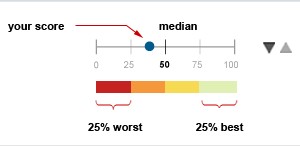
That said, modifications to individual parts can result in increased acceleration ability, or decreased braking ability, etc. So, while the behavior of a car ultimately does have a basis in the physical parts that it has been put together with, the description of the behavior is best expressed as a value along a continuum.
The Dial Settings
So, on a scale of 0-100, for example, with 0 being lowest or none, and 100 being highest or maximum, a car's acceleration trait may have an expression level of "35". Or "87". Got it?
The "Dial" has been set to "35". Or "87". It may have a "default setting", and then a range of settings that it can be set to in response to various other factors.

There are no "normal" individuals with settings at "0" or "100". More likely one will have a "default setting" for a particular filter of "38", another at "78". And, these settings may be changeable in response to relevant external conditions. For example, a person with a base line Analytical Filter setting of "25" may be able to raise it to "55" under the right circumstances. Another individual may only be able to raise it to "30". Still another may have a baseline of "85", but under some conditions may be able to lower it to "55" or "15". Finally, these settings may change with age, since gene expression changes with age.